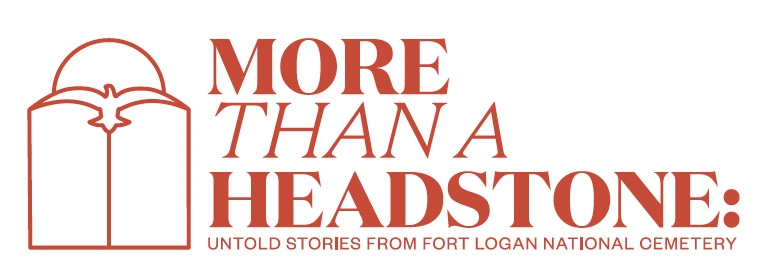Pivotal to U.S. Victory
by Laurel Schlegel
Navajo Code Talkers of the First Marine Division on the island of Peleliu. Edward Leuppe is in the back row, sixth from the left. (U.S. Marine Corps)
Navajo Code Talker Edward D. Leuppe
February 2, 1924-August 24, 1994
Navajo Code Talker, Edward Dale Leuppe, was born on February 2, 1924 to father Kinlichee Nez and mother, A Tah Des Bah, both members of the Navajo Nations tribe.[1] Unfortunately, his mother died during childbirth and his father passed away a few years later.[2] He had three older sisters, one of whom—Mary Denetdale Leuppe—was about 24 years older than Edward. She took him and his two sisters in and raised them as her own. They lived in Buffalo Springs, New Mexico, on the border of New Mexico and Arizona.[3]
As a child, Leuppe was taken by the federal government and sent to an Indian boarding school in Central Oklahoma. There, his life, like that of many indigenous children, underwent significant change, as he and other native youth were forbidden from speaking their native languages. In later years he returned to New Mexico and attended Tohatchi High School. While there, he lived with his sisters and enjoyed playing for his school’s basketball team. During the winters, his family lived in a Hogan, a Navajo style home at the base of the mountains. Each summer his family would move their livestock up to a different dwelling on the top of the mountain to be in the cooler environment.
Leuppe graduated high school in the early 1940s.[4] Looking to explore the world, he enlisted in the U.S. Marines in Santa Fe, New Mexico on March 26th, 1943, at the age of 19.[5] Edward was sent to boot camp at Camp Pendleton in Southern California, where the original 29 Navajo Code Talkers first worked and developed code in order to conceal the movements and plans of the U.S. military from enemy troops.[6] Leuppe’s group of Code Talking Navajo soldiers become the 279th platoon.[7] They had to memorize the entire code because they could not carry references with them in battle.[8] Moreover, the code was so complex that even someone that spoke the Navajo language would be unable to break it. The Code Talkers carried huge responsibilities, as one mistake could cost the lives of many. But in spite of these risks, Code Talkers took part in every assault conducted by the Marines in the Pacific Theater of World War II from 1942 to 1945.[9] Carrying a thirty-five pound radio on their backs, Code Talkers transmitted messages in the Navajo language and cloaked American movement from the Japanese.[10] To this day the code remains unbroken; in fact, the code officially remained a secret until 1982, when President Reagan proclaimed National Code Talker Day.
Leuppe saw action in New Guinea, Cape Gloucester, New Britain, Peleliu Islands, Palau Group, Okinawa, the Ryukyus Islands, and the Occupation of China. He was a Corporal in the 1st Marine Division, 1st Battalion, 7th Marine Regiment. After three years, his service ended on January 22, 1946. He later mentioned to his son that there was no hero’s welcome when they returned to San Diego after the war. They were simply on their own.
Thus, without other options, Leuppe initially headed back to the reservation, and then traveled to the Pacific Northwest and worked on a potato farm for several years.[11] In the early 1950s, Leuppe utilized the G.I. Bill, a federal program that granted stipends for tuition and expenses for veterans attending college or trade schools, to enroll in the New Mexico Highlands University in Las Vegas, New Mexico. While there, he studied industrial arts; he also met Vera Mae Sells, the woman that would become his wife. Together they moved around, taking odd jobs to support their family. They had two daughters, Victoria Dianne, and Mary Carol, and later a son named Edward Dale Leuppe II. Leuppe began working for San Juan Oil and Gas in Farmington, New Mexico during the 1960s. He even ran for city council while living there but unfortunately did not win. In 1969, he was hired as a draftsman by Texaco Gas and Oil so the family moved to Littleton, Colorado.[12] Here he worked for twenty years before retiring.
After retirement Leuppe began playing golf and found a new hobby. He introduced the sport to his son, who also found a love for the game and even made a career out of it.[13] In 1987, Vera Mae passed away from pancreatic cancer. Edward later passed away at age 70 on August 24, 1994 of lung and colon cancer. Both Edward and his wife are buried at Fort Logan National Cemetery.[14] He received the Silver Medal of Honor posthumously for his service in World War II.
Leuppe and the rest of the Navajo Code Talkers are remembered to this day as pivotal to the United States victory during the war. Leuppe was a hero to both his country and his family. To describe Leuppe, his son, Ed Leuppe, explained, “To me, he was a self-made man who was unselfish. He came from nowhere and made his own destination. His family came first with no second thought. To me he is a hero, not only to our country but to our family.”[15]










